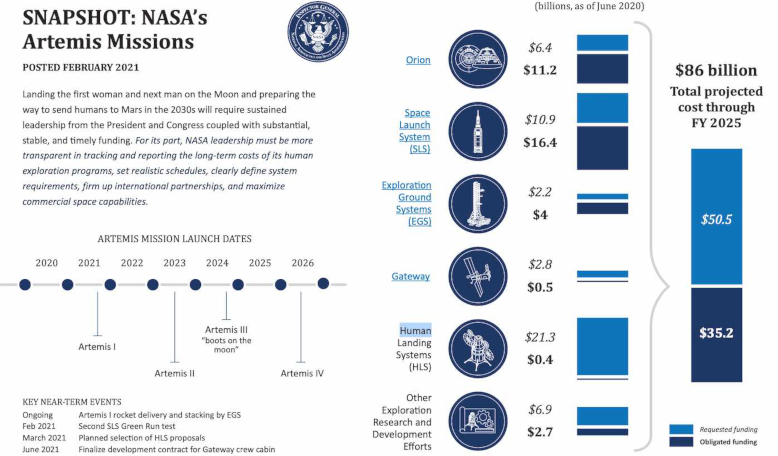NASA’s Office of Inspector General (OIG) has released a snap shot of the costs associated with the space agency’s Artemis programme to land astronauts on the moon. According to the infographic, the total projected cost through fiscal year 2021 to 2025 is $85.7 billion.
The inspector general’s office said about $35 billion of that cost has already been spent on elements such as Orion, the Space Launch System (SLS) and Exploration Ground Systems (EGS), but that around $50.5 billion will need to be budgeted over the next five years to facilitate the programme.
However, whether a five year timescale is still achievable is debatable.
Under its fiscal year 2021 appropriation, NASA has been awarded a congressional budget of $23.3 billion – a 3 percent increase over the previous year's amount.
Although Congress has provided nearly a billion dollars more than requested for NASA’s Science Mission Directorate, Congress have only provided $850 million for work on the three human landing system projects that NASA is currently supporting, well short of the requested $3.37 billion.
The Human Landing System (HLS) is an integral part of the Artemis Programme, but so far the least-developed.
“The one thing that we need is a Human Landing System,” Bridenstine said in an interview last month with Spaceflight Now. “We put together a big budget necessary to achieve that Human Landing System. We asked for $3.3 billion, and Congress funded it to the tune of $850 million in a very bipartisan bill.”
Without the full budget for the lunar lander, “NASA is going to have to do an assessment and make a determination as to whether or not 2024 is going to be achievable or not,” Bridenstine said before he resigned as NASA administrator in January.
This sentiment was also recently echoed by the new Biden Administration when the White House affirmed last week that Artemis will continue.
“Lunar exploration has broad and bicameral support in Congress, most recently detailed in the FY 2021 omnibus spending bill,” White House Press Secretary Jen Psak said at a briefing on 4 February. “Certainly, we support this effort and endeavour.”
Despite offering a broad endorsement of the plan for returning humans to the moon, and onwards to Mars, Psaki gave no indication that the intended 2024 goal established by the Trump administration would be met.
NASA’s goal of returning American astronauts to the surface of the Moon was moved forward to 2024 by then Vice President Pence, who in 2019 directed the agency to accelerate their plans by four years to a date which would have coincided with the last year of a second Trump term if he won reelection; a deadline many felt was unachievable.
With Biden now in charge and a budget unlikely to support a 2024 lunar return, the agency’s initial target for a 2028 moon landing might be back on the cards.











